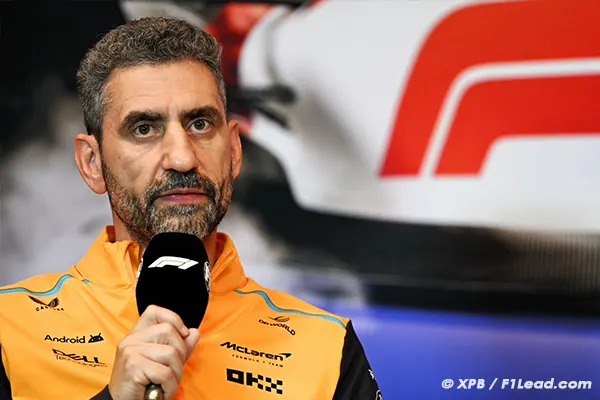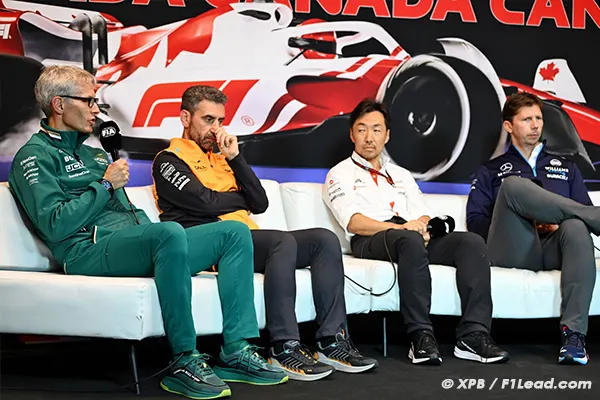Formula 1 team principals express concerns over the FIA’s 2026 regulations, highlighting significant issues that may hinder achieving the sport’s ambitious goals.
Several Formula 1 team principals have voiced their concerns about the capacity of the 2026 technical regulations, in their current form, to achieve the stated ambitions.
The FIA has published the proposal for the next overhaul of the rules, with a planned shift to lighter and smaller cars to enhance the overall racing spectacle.
The 2026 machines aim to reduce weight by 30 kg to 768 kg, while the width will be reduced from 2000 mm to 1900 mm and the wheelbase will be decreased by 200 mm to 3400 mm.
Additionally, the FIA has revealed that active aerodynamics will be used alongside a new “manual overtaking mode” to replace the Drag Reduction System (DRS) as an overtaking aid.
A meeting will take place tomorrow in Montreal between all team principals, F1, and the FIA to discuss the problematic points.
While McLaren F1 team principal Andrea Stella agrees with the main goals the sport aspires to, he believes changes are needed in how these objectives will be achieved.
“We agree and support the intent and the goals outlined in the press release. However, if we examine the regulations in their preliminary form that have been circulated, they are still far from being able to achieve these acceptable goals and intentions.”
“It is therefore time for the FIA, F1, and the teams to work together, to listen to each other, and to contribute to finding a solution that will allow the sport to achieve these objectives. I think if we achieve these goals, Formula 1 will be in good shape.”
“But we must ensure that when it comes time to implement, we deliver a product that truly meets these targets and objectives.”
Elaborating on the issues, Stella argued that the increased electric power of the new power units would put too much pressure on the aero and chassis to compensate.
“I think the main shortcomings lie in Article 3, which concerns the aerodynamic regulations. And the second point is that I still think the way the power units are envisaged needs to be adjusted.”
“We can still achieve a 50-50 concept between thermal and electric, which is a good concept, but it can be realised in a way that does not impose so many requirements at the chassis level, which is difficult to meet.”
“So from the power unit perspective, as well as from the chassis perspective, it is time for all parties to understand that they need to contribute to the success of this sport.”
The active aerodynamics will include two states: a “Z mode” that generates more downforce in corners and an “X mode” that will increase top speed on straights.
However, Stella warned that the 2026 cars as currently planned would be too slow in corners but also too fast on the straights.
“The cars are not fast enough in the corners and too fast on the straights. Both aspects therefore need to be rebalanced.”
Meanwhile, Williams team principal James Vowles agreed that the larger electric components of the power units would make it difficult to achieve the intended weight reduction target.
“Firstly, there is the aerodynamic side, so what we are doing with the freedom or physical speed of the cars. And then the second side is where we are in terms of weight. And I said a few weekends ago, from Williams’ perspective, but I don’t think anyone will reach that particular weight target.”
“It will be incredibly difficult, and I think it needs to be reviewed because there might be someone who spends their life making marginal gains to reduce a car’s weight.”
“On the second point, I completely agree with my peers that if we work together, and we will in the future, we can get to a very good position, I think. It’s a solid foundation to work from, but we need to clarify some aspects.”
Mike Krack, of Aston Martin F1, agreed that adjustments need to be made before the rules are ratified but stressed that these discussions should take place behind closed doors.
“I think we are still quite far from the final version, and I think it is now up to all stakeholders to discuss and work on any issues constructively rather than using the media to try to push something forward. I believe that in the coming weeks and months, we will be able to resolve all remaining issues.”

FIA’s 2026 Regulations Under Scrutiny by Teams. FIA’s 2026 Regulations Under Scrutiny by Teams
- You may also like>Alonso Leads as Rain Disrupts Canada EL2
- Following us on Facebook and Twitter
- Norris rues Saudi crash, eyes lucky break on Sunday
- Sainz Stuns with P6 in Jeddah as Williams Gains Ground
- Bearman Impresses in Jeddah as Ocon Fades in Q1 Exit
- Antonelli Impresses with P5 on the Grid in Jeddah
- Sauber’s Jeddah hopes sink after double Q1 heartbreak
